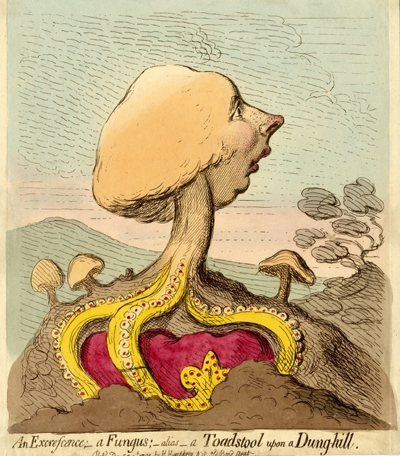Welcome to James Gillray: Caricaturist
Political Caricaturist*

© Trustees of the British Museum
With Gillray's return to the ranks of professional graphic satirists in 1786, we begin to see the succession of brilliant works that prompted Sir David Low to call him "the father of the political cartoon." In 1786, we have A New Way to Pay the National Debt and A Sale of English Beauties in the East-Indies; in 1787, A March to the Bank and Monstrous Craws; and in 1788, Wife or No Wife... and The Morning After Marriage to name just a few.
But Gillray's pre-eminence as a satiric caricaturist did not come quickly or easily. By 1786, Gillray had worked for as many as 20 different printsellers, using a variety of perspectives and techniques, and exploring a wide range of subject matter. If we assume with Draper Hill that Gillray's first prints appeared in 1775, we do not see any real interest in caricature portraits until nearly five years later with two small caricatures of Lady Mount Edgcumbe and Lady Cecilia Johnson. And it is not until 10 years after his start in the printmaking trade that he really finds his metier. By then, his draughtsmanship, his printmaking skills, and his genius for the right visual metaphor to express his complex reactions to political events had been developed and refined over the course of some 150 prints. And this growth was not simply personal; it was part and parcel of the evolution of graphic satire itself.
Graphic satire in England had been around since the 17th century, and got a great boost in popularity in the aftermath of the South Sea Bubble (1720s). But the roots of early graphic satire were in the emblem book tradition where the image (or set of images) was largely allegorical, any figures were more often types than portraits, and the understanding of the image depended (more often than not) upon the reading of an attached explanation or an extensive set of verbal keys or balloons. Laboriousness was inherent in the tradition, so however successful they might have been as satire, these early political prints were anything but witty.
The introduction of caricature in England changed that. Caricature by its very nature is both witty and reductive. At its most basic it consists of an exaggerated or buffoon element of form or feature deflated by an ironic and ruthless economy of line. As Kris and Gombrich pointed out many years ago, caricature is a graphic form of wit. And the success of wit, whether verbal or graphic depends not only upon the appropriateness of the sally but its brevity, simplicity, or succinctness. Not surprisingly, an early definition of caricature stressed that the drawing should take no more than two or three strokes of the pen.
![The Fall of Icarus [1807]. Trustees of the British Museum](images/bm_icarus.jpg)
© Trustees of the British Museum
What we see in Gillray's prints in the 1780s and beyond and in satiric caricature in general as it evolves from the emblem tradition is a simplification of the image so that the essential dramatic situation is immediately apparent. This is sometimes achieved with simply fewer figures as in The State Tinkers [1780] or The Lord of the Vineyard [1783]. But it is also achieved through allusion to a story or a situation which would have been well known to Gillray's audience because it was part of their everyday experience (e.g. Market Day [1788], The Westminster Hunt) [1788] or their shared literary and cultural experience e.g. the Slough of Despond [1793], Lilliputian Substitutes, or The Fall of Icarus [1807]. The terms or outcome of the situation are already familiar, so further explanation becomes unnecessary.
This does not mean that Gillray's prints show no evidence of the earlier emblem tradition. The emblematic image of the scales weighing the truth of a person or thing is used by Gillray in Jack a Both Sides [1783], The Balance of Power [1791], The Cabinetical Balance [1806]. The symbolic figure of Britannia appears throughout Gillray's work in Britannia in French Stays [1793], Britannia between Scylla and Charybdis [1793], and Britannia between Death and the Doctors [1804] Nor does it mean that his prints reveal all their meaning at a single glance. Following Hogarth's lead, Gillray frequently adds background signs, pictures, and enriching details that sometimes amplify and sometimes provide a further ironic perspective on the central action. But in general, there is a perceptible shift from the primacy of a laborious emblematic or allegorical meaning to a witty, and more immediate and expressive meaning created by the wonderful combination of visual and verbal wit.
* The evolution of caricature, especially satiric caricature, in the 18th century has received increasing attention as the importance of caricature as a reflection of 18th century thought has become better appreciated. In addition to Draper Hill and M. Dorothy George, any serious student of Gillray would be well advised to consult one or more of the following books:
- Herbert Atherton, Political Prints in the Age of Hogarth (1974)
- Diana Donald, The Age of Caricature (1996)
- Ronald Paulson, Emblem and Expression (1975)
- Amelia Rauser, Caricature Unmasked (2008)